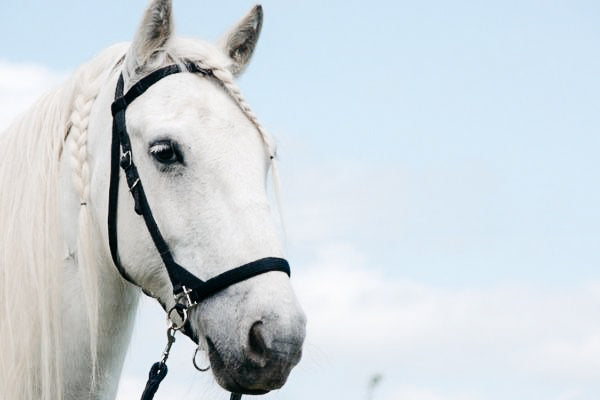
Bitless bridle - great freedom for the horse's mouth
It's hard to believe, but domesticated horses have actually had a kind of gag in their mouths since before Christ. This was antler horn or even animal bones, which people at that time processed and used to "steer" their domestic horses. Some of these early mouthpieces were even sharpened. Not nice. It was only a long time later that metal teeth in the form of a bar developed. Incredibly clunky things that bore little resemblance to our current bridle.
Today, metal is often avoided in equestrian sport. Is there a rethink taking place?
Yes, there really is a kind of revolution to be seen. Since the publication of the work of the clever American university professor Robert Cook, a number of bridles and curbs have been hung up. He associated behavioral disorders and pathological changes in the bone substance with the bridle.
That made people sit up and take notice and the “run” towards bitless bridles began. We would like to introduce you to some of them.
The cavesson
The cavesson has been used traditionally for a very long time. It is used for lunging and working on the ground.
You can also ride with it. It is very important that it sits really well and firmly on the horse's head. Unfortunately, there are a number of unsuitable, ill-fitting models available in stores. That almost ruined the reputation of this bridle. But many professionals remain loyal to him and swear by the meaningful work that he makes possible, especially when training young horses.
Wheel of Fortune
A wheel of fortune on a horse? A very interesting bitless bridle. The idea behind it is as simple as it is practical: cheek, nose and chin straps as well as the reins are attached to a six-spoke wheel (there are now also flower shapes). Depending on the setting, this rotates more or less. The effect varies, so to speak. Either it acts as a gentle side pull or as a lever via the neck (additional shanks can be strapped in). With the Wheel of Fortune the horse can be ridden flexibly. As you need it right now.
The equi bridle
The equi bridle is a multitool for the rider. This bitless bridle can be combined and equipped with extension parts in a variety of ways. The easy-care biothane material is infinitely adjustable and can be easily adapted to any horse's head. Practical if you e.g. b want to work several horses.
With this bridle you can train very flexibly. Whether it's lunging like a cavesson, riding without a bit like with a side pull, or doing elevated leading work by hand - it's all no problem. The robust piece can even be ordered in your favorite color. Thanks to Biothane! In any case, a cool piece!
Bosal (Hackamore)
Now it's getting exotic. The bosal on horses is a bitless bridle that comes from the old Californian riding style. On the outside there is usually a braid made of rawhide and the core of the classic nose arch was also made of rawhide.
IMPORTANT: The bosal must correspond to the horse or horse it belongs to. can really be adjusted precisely to his nose!
The bosal also includes a mecate (reins that are preferably braided from mane and tail hair and promote neck reining due to their scratchy texture).
You probably know that horses react very sensitively through their skin. Keyword: bow tie. Fine communication is therefore possible. The effect of a bosal should come only when applied by the reins attached to the lower part of the bow. If the animal does not react, the nose is treated using a rawhide bow. An instruction or Training sessions from an expert are sensible here.
Bitless Bridle and Star Bridle
With the Bitless Bridle, the throat straps cross each other and continue to the rider's hand through a ring guide as reins. There is more of a pressure on the left side of the horse's head if, for example, you want to ride to the right. There are voices that criticize this variant because of its time-delaying effect. In fact, it has to be said that riding not only involves hand action, but also thighs and weight. Or what do you mean?
The Star Bridles look like a hackamore with their metal levers. So on the nose, the chin and the neck area. There are three adjustment options on the lever. You can therefore make it appear gentle or significantly sharper. In any case, this bridle should be handled with care! You shouldn't underestimate its effect! It only belongs in advanced, knowledgeable hands!
Last but not least - the Hackamore bridle
This bridle is made up of its lever-like features. It is actually also called a mechanical hackamore. Even the slightest pull creates pressure on sensitive areas of the chin, nose and neck. This Hackamore bridle can and should only be used with one hand and belongs in “expert” hands! A steady hand and good riding practice are prerequisites.
Happy without a bit - cheers to equestrian sport!
You can see that a lot has happened in the area of bitless bridles. And yes, equestrian sport has actually been enriched with bitless riding. Whether it's a cavesson, equi bridle or horse's wheel of fortune - every bitless bridle is a step into a world of sensitive communication between horse and rider. Young horse work and correction horses in particular benefit from the versatile possible uses.
Lastly, it should be said again that you shouldn't just jump into it. Good preparation and the assistance of a specialist are definitely recommended in order to firstly put on the bitless bridle correctly and secondly to use it properly. As a result, nothing stands in the way of happy teamwork.
Do you also want to give your horse a break from the snaffle bit? Whether purely for a change or as a conscious extension to the “everyday life”, absolutely recommended!
Discover more posts

Cleverly fill the first-aid kit for emergencies using a checklist
Nothing displeases us riders more than a sick or injured horse. How quickly can it happen that your pet kicks his paws while romping around in the paddock, a fight between other dogs ends in a...
Continue reading
Friese – the versatile, impressive black horses
Of all horse breeds, the Friesian is a horse that particularly stands out due to its impressive appearance. These noble animals were popular at the beginning of the 20th century. In the 19th c...
Continue reading
